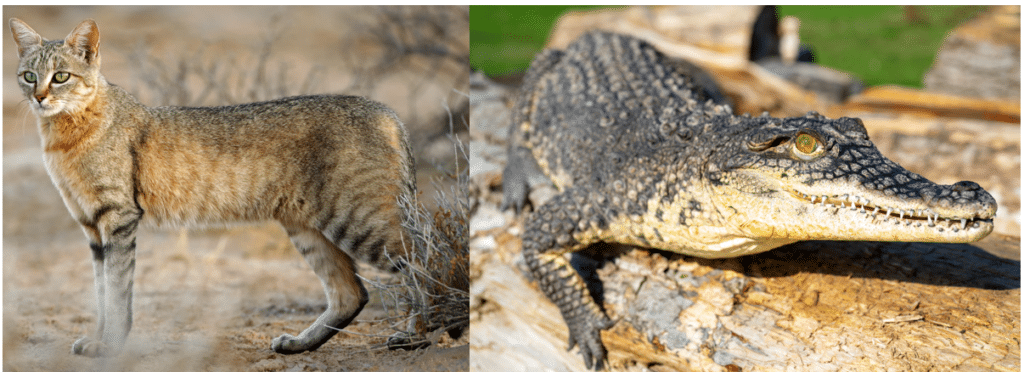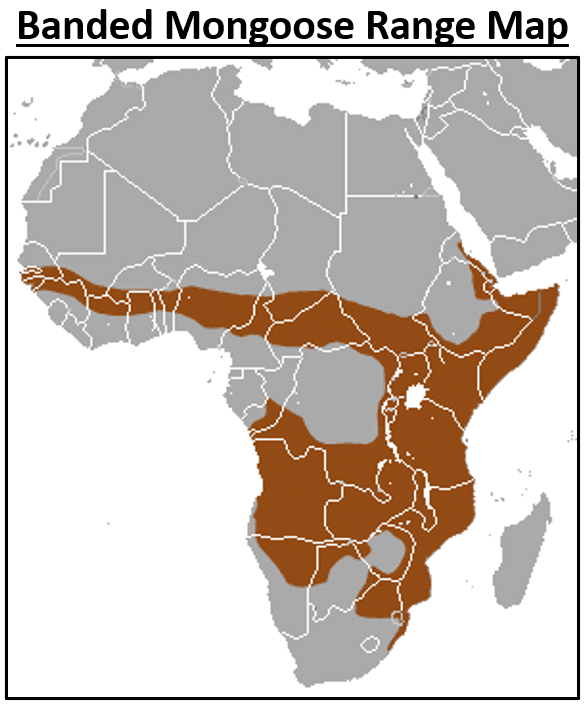5 Fierce PREDATORS found in Somalia! (2025)
What are the different kinds of PREDATORS found in Somalia?

These are often the first animals you think of when you imagine visiting Somalia! The exciting, beautiful, and sometimes terrifying carnivores are some of the most fun to learn about. 🙂
In this article, you’ll find interesting facts, photos, and even range maps of these amazing animals!
5 Predators Found in Somalia:
#1. Spotted Hyena
- Crocuta crocuta

Identifying Characteristics:
- Adults are 95–166 cm (37–65 in) long.
- They have sandy yellowish or gray course, wooly coats with black or dark brown spots on their bodies though these may be absent in old individuals.
- They are strongly built with massive necks, large heads, rounded ears, bushy-tipped tails, and longer front legs than back legs.
Spotted Hyenas are some of the most unique predators in Somalia!
These odd animals live in clans of 3-80 hyenas. Females lead the clans, and all of the females within the clan are dominant over all males. Males and females, there are separate dominance hierarchies.
One of the strangest features about these carnivores is that males and females are very difficult to distinguish. Females have skin and tissue in their genital area that allows them to mimic males, which may protect females from aggression from other females.
Female Spotted Hyenas are incredibly dedicated mothers. Incredibly, they nurse their young until 12 to 16 months of age. By the time the young are weaned, they already have all of their adult teeth which is very rare among carnivorous animals in Somalia.
Spotted Hyenas have a reputation as cowardly scavengers that steal food from other predators, but researchers have found that they kill most of their prey. Despite their odd, sloped appearance, hyenas are incredible runners and will chase prey for long distances at speeds up to 65 kph (40 mph). They usually work in groups to take down large animals.

Although Spotted Hyenas are not currently endangered, they are “Conservation dependent,” meaning that there are currently programs in place to protect them. If the conservation efforts were removed, their populations would begin to decline within five years.
#2. Banded Mongoose
- Mungos mungo

Identifying Characteristics:
- Adults are 30-45 cm (12-18 in) long.
- They have large heads, long tails, small ears, short, muscular limbs, five toes on their front feet with long, curved claws, and four toes on their back feet with shorter, heavier claws.
- They have course brownish-gray coats with dark bands on their backs, dark feet, black-tipped tails, and gray-brown to orange noses.
These cat-like predators live in varied habitats in Somalia.
Look for the Banded Mongoose in grasslands, woodlands, brushlands, and rocky country. They have large ranges, and individuals may travel more than 8 km (5 m) per day while foraging.
They’re primarily insectivores, feeding on termites, earthworms, grasshoppers, scorpions, slugs, and snails, but they’ll also feed on fruit, snakes, crabs, eggs, birds, and rodents. To break hard food like eggs and snails, they throw it at another hard object like a rock.
Banded Mongooses are social and usually live in packs of 10-20 individuals. That said, they’re very possessive of their food and eat it immediately without sharing. Typically, there is one dominant male in each pack.
Incredibly, mating is often synchronized so that the pack’s young are all born within a few days of each other. The entire pack will help care for the young, and lactating females will nurse any baby.
When it’s time to hunt, a few females stay behind to look after the young. Despite this careful guarding, only about 50% of young mongooses make it to 3 months of age.
#3. African Wolf
- Canis lupaster

Identifying Characteristics:
- Adults stand about 40 cm (16 in) tall at the shoulder.
- They have relatively long pointed snouts and ears, comparatively short tails, and robust teeth.
- They’re yellowish to silvery gray with reddish legs, black speckling on their tails and shoulders, and some white markings on their faces, throats, and abdomens.
Look for this carnivore during the day in Somalia in grassland areas.
African Wolves have an extensive range, and their appearance and size vary with location. They usually center their territory around a den, often made from a modified aardvark or warthog den, where the female will have her pups.
African Wolves have flexible social structures that are largely dictated by prey availability. Each pack consists of a monogamous breeding pair that remains together constantly. It also includes current offspring and previous generations that help to raise their siblings.
These wolves can be formidable predators in Somalia, sometimes taking prey up to three times their own weight. However, they usually go after much smaller animals.
Pairs of wolves often hunt gazelle fawns and other small mammals like cane rats and ground squirrels. They also consume fruit, snakes, and insects. Interestingly, during the wildebeest calving season, African Wolves feed almost exclusively on wildebeest afterbirth.
#4. African Clawless Otter
- Aonyx capensis

Identifying Characteristics:
- Adults are 113–163 cm (44–64 in) long.
- They have large heads, stout, tapered tails, partially webbed hind feet, long white whiskers on their cheeks, chin, and brows, and are clawless except for three grooming claws on each hind foot.
- They have thick, shiny dark brown coats with white markings on their upper lips, the sides of their faces, necks, throats, bellies, and lower ears.
These predators are the largest otters in Somalia!
As a primarily aquatic species, you’ll almost always see African Clawless Otters around rivers and springs. They prefer areas with thick reed beds and shallow water because they don’t dive below 1.5 m (5 ft).
African Clawless Otters also spend time on land. They build dens with entrances above or below the water that they share with other otters. They use their dens for giving birth, playing, eating, and resting.
These carnivores breed during the dry season, and the young otters are particularly fun to watch. They spend much of their time fighting, swimming, sliding on rocks, playing with their food, and throwing pebbles into the water to dive and grab before they reach the bottom. Watching them is like a little circus show!
#5. Bat-eared Fox
- Otocyon megalotis

Identifying Characteristics:
- Adults are 46–66 cm (18-26 in) long.
- Coloration is yellow-brown with pale throats and underparts, and black outer ears, raccoon-like face masks, lower legs, feet, and tail tips.
- They have relatively short legs, huge ears, and more molars than other canids.
Look for these predators in the arid grasslands and savannas of Somalia.
Named for their enormous ears, these interesting-looking foxes prefer areas with short grass. They live in large dens with long tunnels and several entrances, and they have multiple dens within their territory.
Bat-eared Foxes arrange their schedule by the weather. In the summertime, they’re mostly nocturnal to avoid the heat of the day, while in the winter, they sleep at night.
They spend much of their time hunting, feeding on insects and other arthropods. They often follow herds of wildebeest, zebra, and buffalo, which feed on the grass, disturbing the termites. Their dung also attracts dung beetles. Their large ears allow them to hear the insects even underground.
Check out these other guides about animals found in Somalia!
-
50 Most Common Animals Found in Somalia!
-
The 10 MOST Common Birds in Somalia!
-
11 COMMON Spiders found in Somalia!
Which of these predators have you seen before in Somalia?
Leave a comment below!






